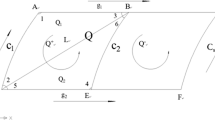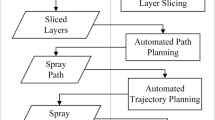Abstract
Automatic trajectory generation for robot manipulators is a highly desirable application for robots, In this paper, we take into account the geometric aspects of trajectory planning, especially the workpiece reconstruction and description used to generate the trajectories. Generating manipulator trajectories for free-form surfaces to satisfy manufacturing requirements is highly challenging due to the complex geometry of free-form surfaces. This paper describes the development of a 3D surface reconstruction guided manipulator trajectory generation system for a magnetic scattering film plating robot. After reviewing existing methods of trajectory generation, an effective trajectory generation method for robotic film plating is introduced and a trajectory planning algorithm that can be used to control a magnetic scattering film plating robot is proposed. A kinematics verification method is also provided to verify the generated trajectories. Results obtained from the simulation and experiments are presented, the results show that the trajectory generation system achieves satisfactory performance. The paper fulfils an identified need for an effective trajectory generation method for magnetic scattering robotic film plating based on the workpiece surface reconstruction after the mesh subdivision. The trajectory generation system can also be used to generate trajectories for many other surface-guided robot trajectory planning applications.
Similar content being viewed by others
References
Alliez, P., Meyer, M., & Desbrun, M. (2002). Interactive geometry remeshing. In ACM Transactions on Graphics (Special issue: Proceedings of ACM SIGGRAPH 2002, San Antonio, Texas, July 23–26, 2002), Vol. 21, No. 3, pp.347–354.
Antonio, J. (May 1994). Optimal trajectory planning for spray coating. In Proceeding of the IEEE International Conference on Robotics & Automation (pp. 2570–2577). San Diego, CA:IEEE.
Atkar, P., Choset, H., & Rizzi, A. (2003). Towards optimal coverage of 2-dimensional surfaces embedded in r3: Choice of start curve. In Proceedings of the 2003 IEEE/RSJ Intl. Conference on Intelligent Robots and Systems (pp. 3581–3587). Las Vegas, Nevada: IEEE.
Berger, U., Lepratti, R., & May, M. (September 2005). An approach for the automatic generation of robot paths from CAD-data. In Proceedings of 10th IEEE International Conference on Emerging Technologies and Factory Automation (pp. 19–22). Catania, Italy: IEEE.
Chen, H., Shen, W., Xi, N., Song, M., & Chen, Y. (May 2002) Automated robot trajectory planning for spray painting of free-form surface in automotive manufacturing. Proceeding of the 2002 IEEE International Conference on Robotics & Automation (pp. 450–455). Washington, DC, NY: IEEE.
Chen, H., Xi, N., Sheng, W., Chen, Y., Roche, A., & Dahl, J. (2003). A general framework for automatic CAD-guided tool planning for surface manufacturing. In Proceedings of the IEEE International Conference on Robotics and Automation (pp. 3504–3509). Taipei, Taiwan: IEEE.
Constantinescu, D., & Croft, E. A. (2000). Smooth and time-optimal trajectory planning for industrial manipulators along specified paths. Journal of Robotic Systems, 17(5), 233–249. doi:10.1002/(SICI)1097-4563(200005)17:5<233::AID-ROB1>3.0. CO;2-Y.
Delta Tau Inc. (2003). PMAC user’s manual.
DeRose, T., Kass, M., & Truong, T. (1998). Subdivision Surfaces in Character Animation. In Proceedings of the 25th Annual Conference on computer Graphics Siggraph ‘98 (pp. 19–24). Orlando, FL: IEEE.
Hoppe H., DeRose T., Duchamp T., Halstead M., Jin H., McDonald J. et al (1994) Piecewise smooth surface reconstruction. Computer Graphics 28(3): 295–302
Lian, G., Sun, Z., & Mu, C. (October 2006). Optimal motion planning passing through kinematic singularities for robot arms. In Proceedings of 2006 IEEE/RSJ International Conference on Intelligent Robots and Systems (pp. 4349–4354). Beijing, China: IEEE.
Loop, C. (1987). Smooth subdivision surfaces based on triangles. Master’s Thesis, Department of Mathematics, University of Utah, 1987.
Shair Arikan, M. A., & Balkan, T. (2000). Process modeling, simulation, and paint thickness measurement for robotic spray painting. Journal of Robotic Systems, 17(9), 479–494. doi:10.1002/1097-4563(200009)17:9<479::AID-ROB3>3.0.CO;2-L.
Sheng W., Xi N., Song M., Chen Y. (2001) CAD-robot motion planning. The Industrial Robot 28(2): 143–151 doi:10.1108/01439910110382738
Shirinzadeh B., Cassidy G., Oetomo D., Alici G., Ang M.H. (2007) Trajectory generation for open-contoured structures in robotic fibre placement. Robotics and Computer-Integrated Manufacturing 23(4): 380–394 doi:10.1016/j.rcim.2006.04.006
Suh S.H., Kang J.K. (1995) Process planning for multi-axis NC machining of free surfaces. International Journal of Production Research 33(10): 2723–2738 doi:10.1080/00207549508904841
Wang X. (2005) Xuepu Bai, technology of Vacuum plating robot. Manufacturing & Automation 27(3): 73–75 (in Chinese)
Author information
Authors and Affiliations
Corresponding author
Rights and permissions
About this article
Cite this article
Liu, J. 3D surface reconstruction based trajectory control for a magnetic scattering film plating robot. J Intell Manuf 20, 719–726 (2009). https://doi.org/10.1007/s10845-008-0160-y
Received:
Accepted:
Published:
Issue Date:
DOI: https://doi.org/10.1007/s10845-008-0160-y




